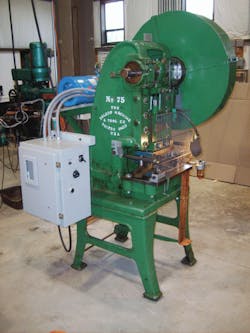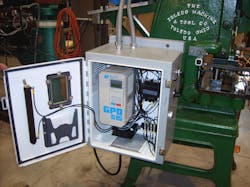Turn-of-the-century stamping press gets new life with variable-speed drive
Upgrades that included a constant-torque flux-vector variable-speed motor let a pre-1912 vintage stamping press handle modern production duties.
The cast-iron press, salvaged for $80, weighed about 3,500 lb. and was made by the Toledo Machine & Tool Co., a firm eventually acquired by press builder Aida, Dayton, Ohio.
Engineers at Patriot Engineering Co., Chagrin Falls, Ohio, first rated the press using finite-element stress analysis. At a 60-ton shock loading, only small areas of the frame showed stresses near 19,800 psi. TheseA 32-in. OD flywheel on the device had stress cracks in its spokes from the many millions of cycles over nearly 100 years of use. These were repaired by welding. Patriot either reground or replaced other worn parts such as journal and crank bearings.
To bring the press in line with modern safety standards, Patriot engineers replaced the old mechanical pin clutch with a Magnetek GPD Series ac drive, which is now marketed by Yaskawa America Inc., Waukegan, Ill.
Analysis revealed an oversized variable-speed electronic drive and motor could replace the old mechanical clutch and brake. Oversizing the motor is key to controlling flywheel momentum. Earlier in its life, the press had been “modernized” from an overhead leather belt drive to a 2-hp electric motor. Patriot engineers calculated that replacing the 2-hp motor with a 3-hp version provided enough margin to bypass the mechanical clutch for starting and stopping the press electronically.
The replacement electronic-drive system consisted of a vector-duty closed-loop blower-cooled motor from Reliance Electric (now part of Baldor Electric Co., division of ABB Ltd., Fort Smith, Ark.) teamed with a flux-vector-duty constant-torque general-purpose ac drive. The original mechanical clutch was permanently engaged and the only parts modified were a slide for tensioning modern multiple V-drive belts.
Resources:


